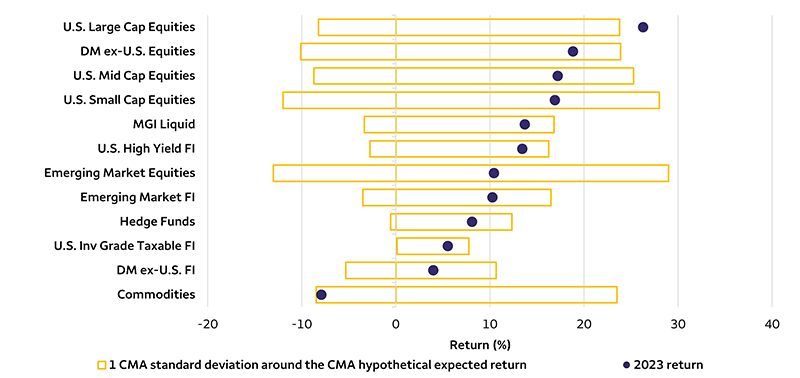Moderate Growth and Income Model: 2% Bloomberg U.S. Treasury Bills (1–3 Month) Index, 30% Bloomberg U.S. Aggregate Bond Index, 6% Bloomberg U.S. Corporate High Yield Bond Index, 5% JPM EMBI Global Index, 24% S&P 500 Index, 10% Russell Midcap Index, 6% Russell 2000 Index, 8% MSCI EAFE Index, 5% MSCI Emerging Markets Index, 4% Bloomberg Commodity Index.
Investment Grade Fixed Income: Bloomberg U.S. Aggregate Bond Index is composed of the Bloomberg U.S. Government/Credit Index and the Bloomberg U.S. Mortgage-Backed Securities Index and includes Treasury issues, agency issues, corporate bond issues, and mortgage-backed securities.
High Yield Fixed Income: Bloomberg U.S. Corporate High Yield Bond Index covers the U.S.-dollar-denominated, non-investment-grade, fixed-rate, taxable corporate bond market. Securities are classified as high yield if the middle rating of Moody’s, Fitch, and S&P is Ba1/BB+/BB= or below. Included issues must have at least one year until final maturity.
Bloomberg Municipal Bond Index is an index of a broad range of investment-grade municipal bonds that measures the performance of the general municipal bond market.
Bloomberg U.S. Aggregate 1–3 Year Bond Index is unmanaged and is composed of the Bloomberg U.S. Government/Credit Index and the Bloomberg U.S. Mortgage-Backed Securities Index and includes Treasury issues, agency issues, corporate bond issues, and mortgage-backed securities with maturities of one to three years.
Bloomberg U.S. Aggregate 10+ Year Bond Index is unmanaged and is composed of the Bloomberg U.S. Government/Credit Index and the Bloomberg U.S. Mortgage-Backed Securities Index and includes Treasury issues, agency issues, corporate bond issues, and mortgage-backed securities with maturities of 10 years or more.
Cash Alternatives: Bloomberg 1–3 Month U.S. Treasury Bill Index includes all publicly issued zero-coupon U.S. Treasury bills that have a remaining maturity of less than 3 months and more than 1 month, are rated investment grade, and have $250 million or more of outstanding face value. In addition, the securities must be denominated in U.S. dollars and must be fixed rate and non-convertible.
Commodities: Bloomberg Commodity Index is a broadly diversified index of commodity futures on 20 physical commodities, subdivided into energy, U.S. agriculture, livestock, precious metals, and industrial metals sectors. Commodity weights are derived in a manner that attempts to fairly represent the importance of a diversified group of commodities to the world economy.
Developed Market ex-U.S. Fixed Income: JP Morgan Government Bond Index Global Ex U.S. Index (JPM GBI Global Ex-U.S.) is a total return, market-capitalization-weighted index, rebalanced monthly, consisting of the following countries: Australia, Germany, Spain, Belgium, Italy, Sweden, Canada, Japan, the United Kingdom, Denmark, the Netherlands, and France.
Emerging Market Fixed Income: JPM EMBI Global Index is a U.S.-dollar-denominated, investible, market-capitalization-weighted index representing a broad universe of emerging market sovereign and quasi-sovereign debt. While products in the asset class have become more diverse, focusing on both local currency and corporate issuance, there is currently no widely accepted aggregate index reflecting the broader opportunity set available, although the asset class is evolving. By using the same index provider as the one used in the developed market bonds asset class, there is consistent categorization of countries among developed international bonds (ex. U.S.) and emerging market bonds.
Developed Market ex-U.S. Equities: MSCI EAFE Index (Europe, Australasia, Far East) Index is a free-float-adjusted market-capitalization-weighted index designed to measure the equity market performance of developed markets, excluding the U.S. and Canada.
Emerging Market Equities: MSCI Emerging Markets Index is a free-float-adjusted market-capitalization-weighted index designed to measure equity market performance of emerging markets.
U.S. Small Cap Equities: Russell 2000® Index measures the performance of the 2,000 smallest companies in the Russell 3000® Index, which represents approximately 8% of the total market capitalization of the Russell 3000 Index.
U.S. Mid Cap Equities: Russell Midcap® Index measures the performance of the 800 smallest companies in the Russell 1000® Index, which represent approximately 25% of the total market capitalization of the Russell 1000 Index.
U.S. Large Cap Equities: S&P 500 Index consists of 500 stocks chosen for market size, liquidity, and industry group representation. It is a market-value-weighted index with each stock’s weight in the index proportionate to its market value.
HFRI Fund Weighted Composite Index is a fund-weighted (equal-weighted) index designed to measure the total returns (net of fees) of the approximately 2,000 hedge funds that comprise the Index. Constituent funds must have either $50 million under management or a track record of greater than 12 months. Substrategies include HFRI Event-Driven, Distressed/Restructuring Index, and HFRI Event-Driven (Total) Index.
Note: While the HFRI indexes are frequently used, they have limitations (some of which are typical of other widely used indexes). These limitations include survivorship bias (the returns of the indexes may not be representative of all the hedge funds in the universe because of the tendency of lower performing funds to leave the index); heterogeneity (not all hedge funds are alike or comparable to one another, and the index may not accurately reflect the performance of a described style); and limited data (many hedge funds do not report to indexes, and, therefore, the index may omit funds, the inclusion of which might significantly affect the performance shown. The HFRI indexes are based on information self‐reported by hedge fund managers that decide on their own, at any time, whether or not they want to provide, or continue to provide, information to HFR Asset Management, L.L.C. Results for funds that go out of business are included in the index until the date that they cease operations. Therefore, these indexes may not be complete or accurate representations of the hedge fund universe, and may be biased in several ways. Returns of the underlying hedge funds are net of fees and are denominated in USD.
An index is unmanaged and not available for direct investment.
1. All rights reserved. The information contained herein: (1) is proprietary to Morningstar and/or its content providers; (2) may not be copied or distributed; and (3) is not warranted to be accurate, complete or timely. Neither Morningstar nor its content providers are responsible for any damages or losses arising from any use of this information.
All investments are subject to market risk which means their value may fluctuate in response to general economic and market conditions, the prospects of individual companies, and industry sectors due to numerous factors some of which may be unpredictable. Be sure you understand and are able to bear the associated market, liquidity, credit, yield fluctuation and other risks involved in an investment in a particular strategy.
Equity securities are subject to market risk which means their value may fluctuate in response to general economic and market conditions and the perception of individual issuers. Investments in equity securities are generally more volatile than other types of securities.
Investments in fixed-income securities are subject to interest rate, credit/default, liquidity, inflation and other risks. Bond prices fluctuate inversely to changes in interest rates. Therefore, a general rise in interest rates can result in the decline in the bond’s price. Credit risk is the risk that an issuer will default on payments of interest and principal. This risk is higher when investing in high yield bonds, also known as junk bonds, which have lower ratings and are subject to greater volatility. If sold prior to maturity, fixed income securities are subject to market risk. All fixed income investments may be worth less than their original cost upon redemption or maturity.
Investing in foreign securities presents certain risks not associated with domestic investments, such as currency fluctuation, political and economic instability, and different accounting standards. This may result in greater share price volatility. These risks are heightened in emerging markets.
Exposure to the commodities markets may subject an investment to greater share price volatility than an investment in traditional equity or debt securities. Investments in commodities may be affected by changes in overall market movements, commodity index volatility, changes in interest rates or factors affecting a particular industry or commodity. Products that invest in commodities may employ more complex strategies which may expose investors to additional risks.
Hedge funds are complex, speculative investment vehicles and are not appropriate for all investors. They are generally open to qualified investors only and carry high costs, substantial risks, and may be highly volatile. There is often limited (or even non-existent) liquidity and a lack of transparency regarding the underlying assets. They do not represent a complete investment program. The investment returns may fluctuate and are subject to market volatility, so that an investor’s shares, when redeemed or sold, may be worth more or less than their original cost. Hedge funds are not required to provide investors with periodic pricing or valuation and are not subject to the same regulatory requirements as mutual funds. Investing in hedge funds may also involve tax consequences. Speak to your tax advisor before investing. Investors in funds of hedge funds will incur asset-based fees and expenses at the fund level and indirect fees, expenses and asset-based compensation of investment funds in which these funds invest. An investment in a hedge fund involves the risks inherent in an investment in securities, as well as specific risks associated with limited liquidity, the use of leverage, short sales, options, futures, derivative instruments, investments in non-U.S. securities, “junk” bonds and illiquid investments. There can be no assurances that a manager’s strategy (hedging or otherwise) will be successful or that a manager will use these strategies with respect to all or any portion of a portfolio. Please carefully review the Private Placement Memorandum or other offering documents for complete information regarding terms, including all applicable fees, as well as other factors you should consider before investing.
Global Investment Strategy (GIS) is a division of Wells Fargo Investment Institute, Inc. (WFII). WFII is a registered investment adviser and wholly-owned subsidiary of Wells Fargo Bank, N.A., a bank affiliate of Wells Fargo & Company.
The information in this report was prepared by Global Investment Strategy (GIS). Opinions represent GIS' opinion as of the date of this report and are for general information purposes only and are not intended to predict or guarantee the future performance of any individual security, market sector or the markets generally. GIS does not undertake to advise you of any change in its opinions or the information contained in this report. Wells Fargo & Company affiliates may issue reports or have opinions that are inconsistent with, and reach different conclusions from, this report. Past performance is no guarantee of future results.
The information contained herein constitutes general information and is not directed to, designed for, or individually tailored to, any particular investor or potential investor. This report is not intended to be a client-specific suitability or best interest analysis or recommendation, an offer to participate in any investment, or a recommendation to buy, hold or sell securities. Do not use this report as the sole basis for investment decisions. Do not select an asset class or investment product based on performance alone. Consider all relevant information, including your existing portfolio, investment objectives, risk tolerance, liquidity needs and investment time horizon. The material contained herein has been prepared from sources and data we believe to be reliable but we make no guarantee to its accuracy or completeness.
Wells Fargo Advisors is registered with the U.S. Securities and Exchange Commission and the Financial Industry Regulatory Authority, but is not licensed or registered with any financial services regulatory authority outside of the U.S. Non-U.S. residents who maintain U.S.-based financial services account(s) with Wells Fargo Advisors may not be afforded certain protections conferred by legislation and regulations in their country of residence in respect of any investments, investment transactions or communications made with Wells Fargo Advisors.
Wells Fargo Advisors is a trade name used by Wells Fargo Clearing Services, LLC and Wells Fargo Advisors Financial Network, LLC, Members SIPC, separate registered broker-dealers and non-bank affiliates of Wells Fargo & Company.
©2024 Wells Fargo Investment Institute. All rights reserved.





 Sources: © Morningstar Direct(1) and Wells Fargo Investment Institute. Data from January 1, 2023, to December 31, 2023. For illustrative purposes only. Performance results for Moderate Growth and Income (MGI) Liquid are calculated using blended index returns. Please see Table 1 for the names of the indexes representing the asset classes and important information on index returns. An index is unmanaged and not available for direct investment. Past performance is no guarantee of future results.
Sources: © Morningstar Direct(1) and Wells Fargo Investment Institute. Data from January 1, 2023, to December 31, 2023. For illustrative purposes only. Performance results for Moderate Growth and Income (MGI) Liquid are calculated using blended index returns. Please see Table 1 for the names of the indexes representing the asset classes and important information on index returns. An index is unmanaged and not available for direct investment. Past performance is no guarantee of future results.
